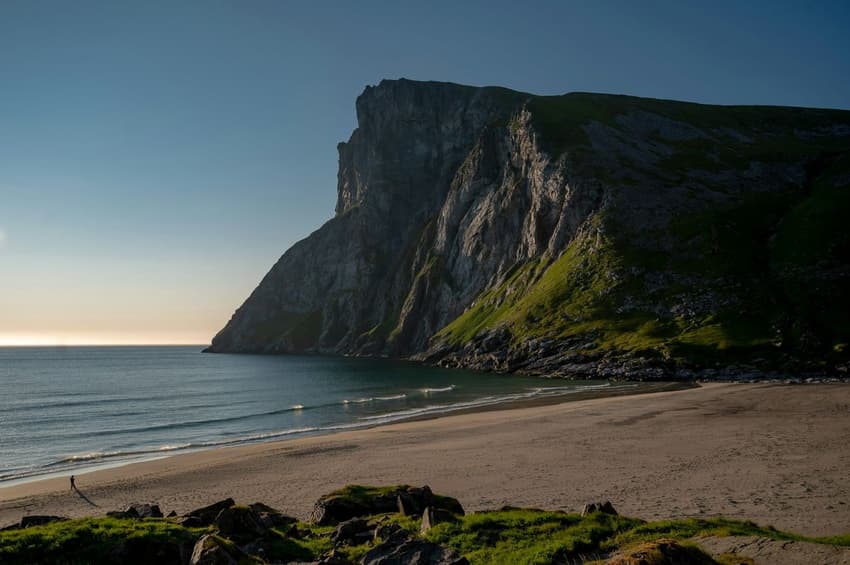How to check the water quality when swimming in Norway

Known for its pristine nature, it's no wonder many dip into Norway's lakes, rivers and fjords. Here's how you can check the water quality.
When you see a great spot of water to paddle in, it's natural to want the water quality to match the surroundings—after all, nobody wants to pick up a nasty bug while going for a swim.
Thankfully, water quality is taken relatively seriously in Norway. For example, out of more than 40 open swimming spots monitored in Oslo, covering beaches, lakes, and fjordside spots, just three received a "bad rating."
These ratings were based on the water's appearance, but also on lab tests for bacterial levels.
Tests of the quality of water occur fairly regularly, and factors such as the weather and the water becoming contaminated can affect the overall water levels.
Checking the water quality before you pick a spot to go swimming can help inform your trip.
Where to find water quality information
Local authorities in Norway will publish information on the quality of the water. Samples are typically collected from the most popular spots, meaning you may not have information for every spot you wish to check.
Oslo Municipality tracks the water quality of 49 saltwater and freshwater swimming areas.
The authorities in Bergen also take weekly readings of the water quality across 23 different spots open to the public.
Water quality is also regularly monitored in Trondheim, and like with other local authorities – regular warnings are posted. You can find ratings for each of Trondheim's public swimming spots here.
To check your local area, simply search badevannskvalitet followed by the municipality. Not every area will have a dedicated section for water quality checks. You can also search for just vannkvalitet.
However, other ways would be to ask local outdoor groups about areas prone to issues.
Furthermore, there are some general tips to help you avoid poor-quality water. Typically, be wary of the water quality after heavy rainfall, as sewage may have overflowed in waterways, or contaminants may spill into the water.
Areas with blue-green algae should also be avoided, as they can cause skin irritation and an upset stomach. They can also cause very serious health issues for pets.
What if there are issues?
When a water issue is found, the municipality typically issues a notice for the public, which is posted on its website or appears in the local press. Furthermore, health authorities in Norway also publish information on specific issues.
For example, the Norwegian Institute of Public Health has an overview of all the waters in which the parasite "swimmers itch" has been discovered.
It has also published information on the potential health risks of swimming in Norway.
Comments
See Also
When you see a great spot of water to paddle in, it's natural to want the water quality to match the surroundings—after all, nobody wants to pick up a nasty bug while going for a swim.
Thankfully, water quality is taken relatively seriously in Norway. For example, out of more than 40 open swimming spots monitored in Oslo, covering beaches, lakes, and fjordside spots, just three received a "bad rating."
These ratings were based on the water's appearance, but also on lab tests for bacterial levels.
Tests of the quality of water occur fairly regularly, and factors such as the weather and the water becoming contaminated can affect the overall water levels.
Checking the water quality before you pick a spot to go swimming can help inform your trip.
Where to find water quality information
Local authorities in Norway will publish information on the quality of the water. Samples are typically collected from the most popular spots, meaning you may not have information for every spot you wish to check.
Oslo Municipality tracks the water quality of 49 saltwater and freshwater swimming areas.
The authorities in Bergen also take weekly readings of the water quality across 23 different spots open to the public.
Water quality is also regularly monitored in Trondheim, and like with other local authorities – regular warnings are posted. You can find ratings for each of Trondheim's public swimming spots here.
To check your local area, simply search badevannskvalitet followed by the municipality. Not every area will have a dedicated section for water quality checks. You can also search for just vannkvalitet.
However, other ways would be to ask local outdoor groups about areas prone to issues.
Furthermore, there are some general tips to help you avoid poor-quality water. Typically, be wary of the water quality after heavy rainfall, as sewage may have overflowed in waterways, or contaminants may spill into the water.
Areas with blue-green algae should also be avoided, as they can cause skin irritation and an upset stomach. They can also cause very serious health issues for pets.
What if there are issues?
When a water issue is found, the municipality typically issues a notice for the public, which is posted on its website or appears in the local press. Furthermore, health authorities in Norway also publish information on specific issues.
For example, the Norwegian Institute of Public Health has an overview of all the waters in which the parasite "swimmers itch" has been discovered.
It has also published information on the potential health risks of swimming in Norway.
Join the conversation in our comments section below. Share your own views and experience and if you have a question or suggestion for our journalists then email us at [email protected].
Please keep comments civil, constructive and on topic – and make sure to read our terms of use before getting involved.
Please log in here to leave a comment.